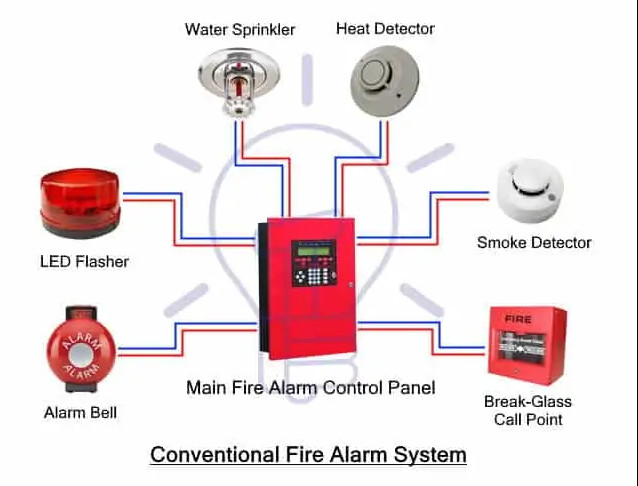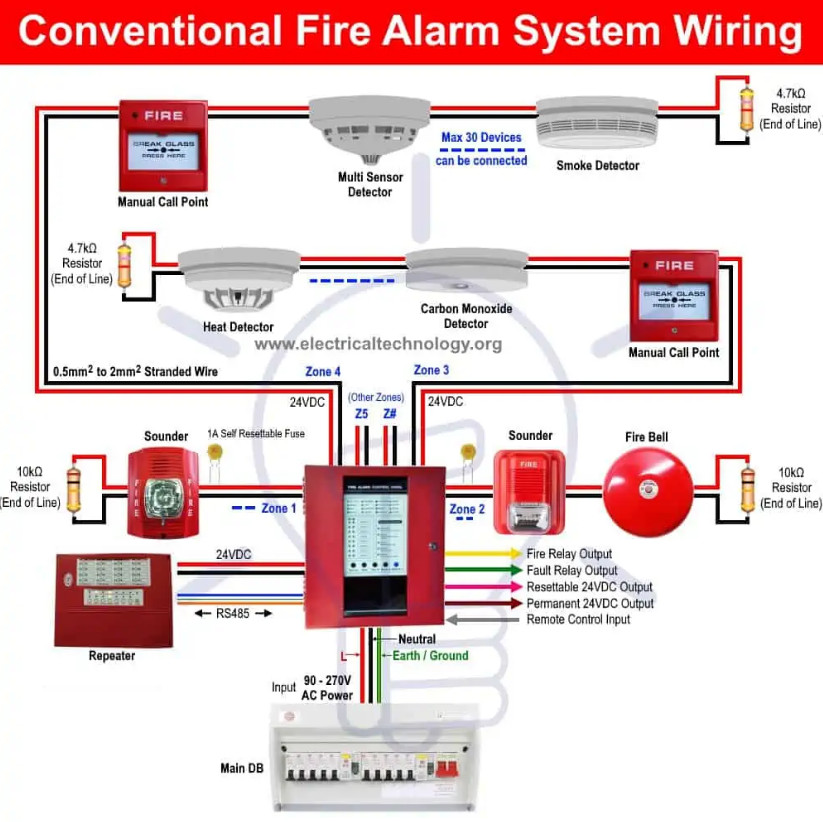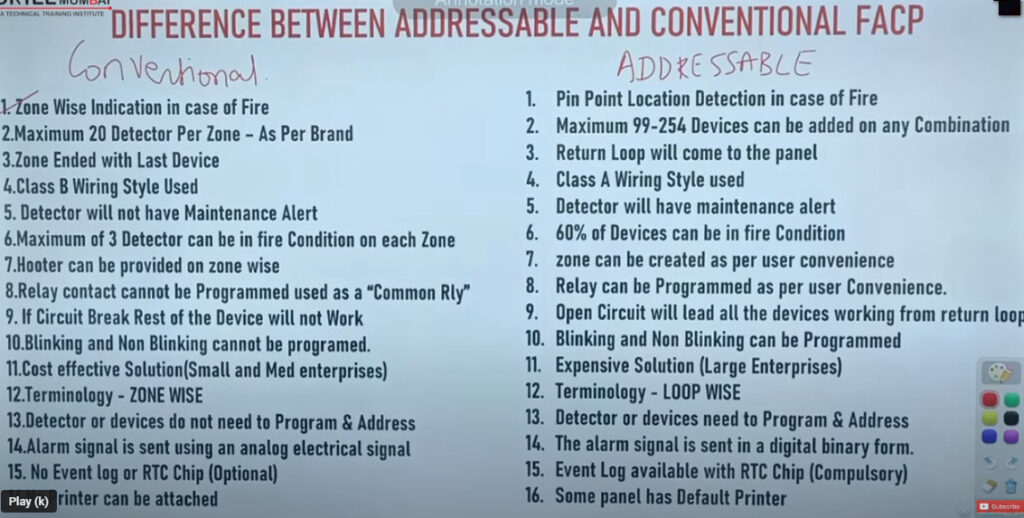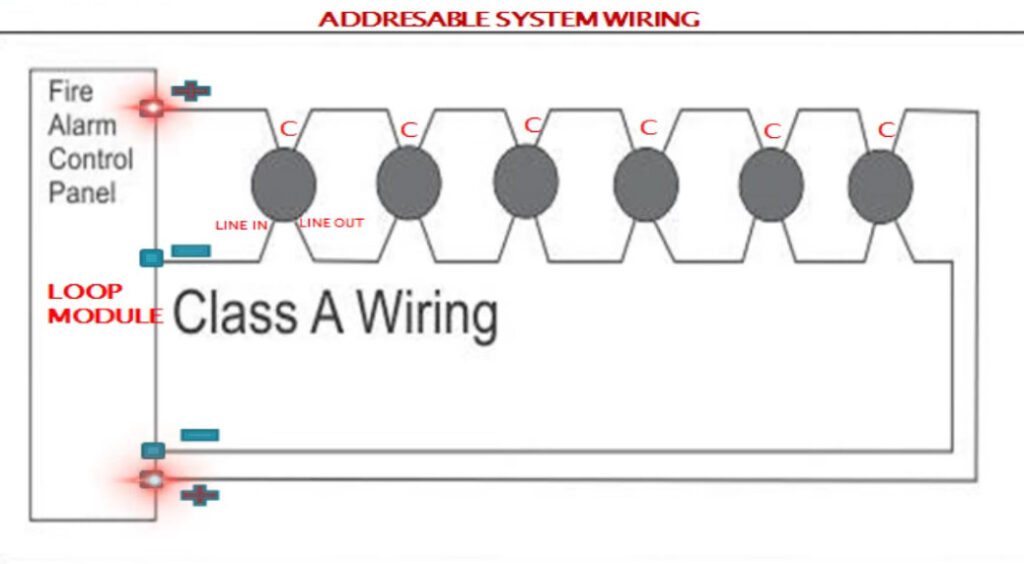- 8777701917
- info@saikatinfotech.com
- Basirhat W.B
The key difference between Conventional and Addressable fire alarm systems lies in the way they identify and communicate the location of a fire, along with the complexity, cost, and features. Below is a detailed comparison of both systems:
Conventional Fire Alarm System:
Addressable Fire Alarm System:
Conventional Fire Alarm System:
Addressable Fire Alarm System:
| Feature | Conventional Fire Alarm | Addressable Fire Alarm |
|---|---|---|
| System Design | Zone-based, no device-specific info | Device-specific, each has an address |
| Alarm Location | Zone-based (no exact location) | Precise location of activated device |
| Wiring | Multiple circuits for each zone | Single loop for all devices |
| Cost | Lower for smaller setups | Higher, but efficient for larger setups |
| Maintenance | More difficult, zone-based troubleshooting | Easier, individual device status |
| Expansion | Difficult, more wiring for zones | Easily scalable, minimal wiring changes |
| Response Time | Slower, requires manual search | Faster, specific location known |
| Complexity | Simpler, easier to install | More complex, more features |
| Best for | Smaller, low-risk buildings | Larger, complex buildings |
In summary, a Conventional Fire Alarm System is a simpler and more cost-effective choice for smaller buildings with basic needs, while an Addressable Fire Alarm System is ideal for larger, more complex buildings where precise location identification, scalability, and faster response times are crucial.

A fire alarm system is a system of various interconnected devices spread throughout a location to notify the residents of a possible fire hazards inside the building. The devices such as smoke detectors, Heat detector, call points, sprinklers, LED flasher and buzzers are connected with a control cabinet called main fire alarm control panel.
There are two different types of fire alarm system i.e. Conventional and addressable fire alarm system. Both types of systems are used in building. However, before installing, it is very important to understand the main differences between them as it will affect the type of business you are running.

The main difference is the configuration or the connection of the devices with the main control panel. There is a separate circuit or wired connection for each device as shown in the figure.
Since there are separate wires for each device, the cost for cables and the installation cost is relatively higher than addressable fire alarm. But the main control panel is quite simple and cheap which reduces the overall cost of the conventional fire alarm. Therefore they are used in business having smaller building sizes and lower budget.
Each circuit connected with the main panel is used for monitoring a specified area known as zones. For example, each floor of a multi-storied building can be divided into zones. Each floor has multiple sensors and detectors connected with the main control panel through a single circuit.
The main disadvantage of conventional fire alarm system is that in case of fire indication, it will only detect the whole floor. It cannot pinpoint the exact location of the triggered alarm in the floor. The reason is that the sensors and devices triggers when the input cross certain threshold and send electrical signal to the main control panel through the common wire. Therefore, the main penal detects it as the whole zone (circuit).
Since it cannot pinpoint the exact location of the fire in the building, it is difficult for fire fighter to find the exact location and extinguish the fire before it cause further damage.
In case the device connected in a circuit stops working or if the wire of the circuit breaks, it is quite difficult to spot the fault. You need to check each device in the circuit to spot the faulty one.
The following diagram shows the basic wiring diagram of a conventional fire alarm system.

As the name suggest, the addressable fire alarm system assigned each individual devices a unique address. It is a digital updated version of the conventional fire alarm where each detectors or sensors have unique identity. Therefore, each device has its own identity which makes it easier to identify which device has been triggered and spot the location of fire. The system quickly notifies the local responders to take the necessary action to stop further damage.
The wiring of addressable fire alarm is very simple. They are connected in a single loop thus saving the cost of wiring and installation. However, the equipment used is quite expensive and the initial cost of the system is quite high. Therefore, such systems are suitable for large buildings having many rooms and have high budget.
It is a digital system with a digitally programmable main control panel that allows to program the threshold of the detectors. This feature allows it to be used in any kind of environment and prevent any false alarm that could end up wasting first responder’s resources and affect the business.
Apart from that, the control panel can detect any faulty device and its exact location in order to replace or troubleshoot the said device. The smart programmable control panel can also be programmed to detect any potential fire hazard (such as gas leaks) and notify the personnel to remove it before the buzzer is triggered.
Since the detectors are connected to the main panel through both ends of the wire, break at one end of the wire will not affect its operation as it can send the signal through the other end. This feature makes it more reliable than conventional fire alarm.
The following diagram shows the basic wiring diagram of an addressable fire alarm system.




The following comparison table shows the key differences between addressable and conventional fire alarm systems.
| Conventional Fire Alarm | Addressable Fire Alarm |
| The fire alarm system where the each detector is connected using separate parallel circuit to the control panel. | The fire alarm system where the detectors are connected using a single loop of wire to the main control panel. |
| The detectors inside a circuit cannot be distinguished from each other. | The detectors are assigned with unique binary address. |
| There are 1 or more than 1 circuits. | There is only one circuit. |
| It requires more wires to connect each device. | It require less wires as it uses only one circuit. |
| It cannot pin point the exact location of fire in a building. | It can pinpoint the exact location of fire. |
| The main control panel is not programmable. | The main control panel is programmable. |
| The alarm signal is sent using an analog electrical signal. | The alarm signal is sent in a digital binary form. |
| The detector’s threshold cannot be programmed. | The detector’s threshold can be programed according to the environment. |
| It is more affected by false alarms. | it nullifies any false alarms due to its programmable features. |
| There is no such warning feature for potential fire hazard. | It carefully monitors and based on smart decision send warning for potential fire hazard in a specific location. |
| There is no RTC (real time clock) chip. | The RTC chip offer a. event log for analysis. |
| The Conventional alarm system is less reliable. | The addressable system is far more reliable than conventional system. |
| The installation takes many labor hours and cost more than addressable fire alarm. | The installation is easier and can be quickly installed with minimum investment. |
| The overall equipment used in conventional fire alarm is very cheap. | The overall equipment used is very expensive. |
| It is used for small offices or building where such smart system is not necessary. | It is used for large buildings with business where they can’t afford to lose any time. |
Overall, the conventional fire alarm is inexpensive and used in small building. however, the addressable fire alarm is very smart and sophisticated system which is very expensive but it is more reliable. Bottom line, conventional fire alarm should be installed in building where it is easier to spot the fire (such as in building having fewer rooms) While the addressable fire alarm should be installed in large buildings.
